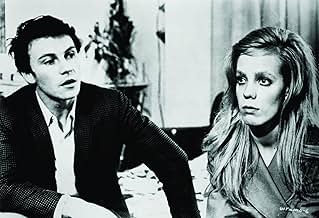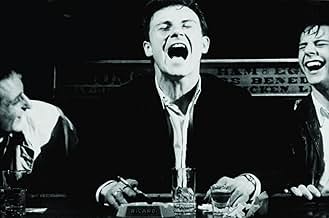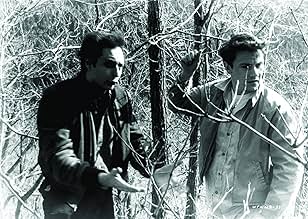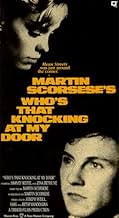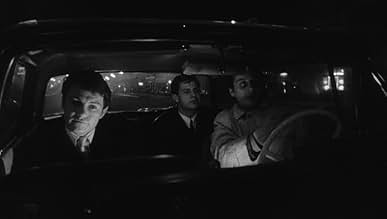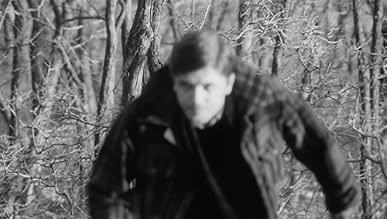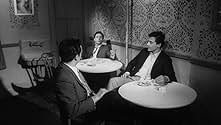VALUTAZIONE IMDb
6,5/10
10.578
LA TUA VALUTAZIONE
Un giovane si scontra con il fatto che la sua ragazza è stata violentata.Un giovane si scontra con il fatto che la sua ragazza è stata violentata.Un giovane si scontra con il fatto che la sua ragazza è stata violentata.
- Regia
- Sceneggiatura
- Star
- Premi
- 1 candidatura in totale
Anne Collette
- Girl in Dream
- (as Ann Collette)
Philip Carlson
- Boy in Copake
- (as Phil Carlson)
Marrissa Joffre
- Girl at Party
- (as Marrisa Joffrey)
Victor Magnotta
- Boy in Fight
- (as Vic Magnotta)
Thomas Aiello
- Minor Role
- (non citato nei titoli originali)
Recensioni in evidenza
This is a hard movie to review because it's essentially an amalgam of several different shorter student films, and some work better than others.
That said, at the crux of "Who's That Knocking at My Door" (the final mass-released version) is a complex character-study laden with Catholic guilt and burdened by all the inherent stigmas and traditions of growing up Italian-American.
Obviously Scorsece knew his source material very well. More than half of the players and virtually all the locations come straight from his own life. What's really cool about the film, though, is how honestly he portrays these sociological nuances. He doesn't tell you Keitel's character's views and attitudes are good or bad, they just "are" --- and it's obvious how the character developed them from a peek into his everyday world.
This bracing honesty is the most appealing thing about the film, along with some drop-dead gorgeous camera work and editing featured here. The first scene where Keitel meets Bethune on the ferry has got to be one of the most imaginatively-shot and enthrallingly staged boy-meets-girl moments on celluloid. Throughout the film, Scorcese overlays soundless scenes from the past and future, creating interesting juxtapositions, always engaging and challenging your perceptions.
With a lot of debuts there are missteps. I don't think that fairly characterizes this movie however. There are definitely parts that drag and don't work well but seen in the context of a shorter film, they would have been more effective. As they're all blended together here, the pacing sometimes suffers.
It's hard to imagine any of the fans of Scorsece's later works, which rely so heavily on hyper-real camera-work and tightly-structured story lines, to have the patience for "Who's That Knocking." But for those who really enjoy the thoughtfulness, subversiveness, and subtext of Scorcese's films, it's a treat to see their origins so prominently displayed.
That said, at the crux of "Who's That Knocking at My Door" (the final mass-released version) is a complex character-study laden with Catholic guilt and burdened by all the inherent stigmas and traditions of growing up Italian-American.
Obviously Scorsece knew his source material very well. More than half of the players and virtually all the locations come straight from his own life. What's really cool about the film, though, is how honestly he portrays these sociological nuances. He doesn't tell you Keitel's character's views and attitudes are good or bad, they just "are" --- and it's obvious how the character developed them from a peek into his everyday world.
This bracing honesty is the most appealing thing about the film, along with some drop-dead gorgeous camera work and editing featured here. The first scene where Keitel meets Bethune on the ferry has got to be one of the most imaginatively-shot and enthrallingly staged boy-meets-girl moments on celluloid. Throughout the film, Scorcese overlays soundless scenes from the past and future, creating interesting juxtapositions, always engaging and challenging your perceptions.
With a lot of debuts there are missteps. I don't think that fairly characterizes this movie however. There are definitely parts that drag and don't work well but seen in the context of a shorter film, they would have been more effective. As they're all blended together here, the pacing sometimes suffers.
It's hard to imagine any of the fans of Scorsece's later works, which rely so heavily on hyper-real camera-work and tightly-structured story lines, to have the patience for "Who's That Knocking." But for those who really enjoy the thoughtfulness, subversiveness, and subtext of Scorcese's films, it's a treat to see their origins so prominently displayed.
a definite must for all scorsese fans. runs much like a student film. Use of music is still very ruff in this film. Not nearly as effective as in mean streets. Many of the same ideas scorsese will later work out in mean streets. Harvey Keitel's performance is powerful. Filmed mostly on Elizabeth St where scorsese grew up and his childhood apartment. highly recommended
"Who's that knocking at my door" is along with "Boxcar Bertha" the most unknown picture of the Italian-American genius Scorsese. Make no mistakes: it's nothing like a masterpiece and it's no surprise that almost no one know about this movie, but here we got some of the constants in Marty's cinema: the street talking, the violence, the outsiders... Those things that "mean streets" dealt about... This was Martin Scorsese's debut and so it was for his friend Harvey Keytel who plays a chauvinist-bad tempered young man.
So, this is a movie that I recommend to those who really love Scorsese's work and wanna know about his origins.
*My rate: 6/10
So, this is a movie that I recommend to those who really love Scorsese's work and wanna know about his origins.
*My rate: 6/10
Here is Martin Scorsese's first feature film, and already, at a mere 25 years old in 1967, it is clear this young man had the determination and eye for visceral images, solid acting and a great ear for soundtracks. A rather raw and unpolished work, Who's That Knocking at My Door works in other ways such as the professionally-done editing by the great Thelma Schoonmaker, another future Scorsese collaborator. In the lead role is a very young Harvey Keitel, who plays the role of a young New York Italian very similar to the nature and style of Martin Scorsese himself. Clearly, there was a special bond between these two that continued for years.
The plot, while at times veering wildly off track, focuses on a young couple attempting to overcome a difficult instance in the past that still looms over the future. With numerous Catholic images and references, this is one of the more explicitly religious of Scorsese's work but there is still a definitive drive behind everything. It is certainly worth watching for anyone who is interested in making their own film as well as any fan of Scorsese eager to know how he got to where he is today. Not always great, sometimes very powerful, this film still remains a strong piece of work that encompasses much of future themes Scorsese would come back to: Catholic guilt, relationships between street friends and the difficulties of romance.
The plot, while at times veering wildly off track, focuses on a young couple attempting to overcome a difficult instance in the past that still looms over the future. With numerous Catholic images and references, this is one of the more explicitly religious of Scorsese's work but there is still a definitive drive behind everything. It is certainly worth watching for anyone who is interested in making their own film as well as any fan of Scorsese eager to know how he got to where he is today. Not always great, sometimes very powerful, this film still remains a strong piece of work that encompasses much of future themes Scorsese would come back to: Catholic guilt, relationships between street friends and the difficulties of romance.
A well-dressed but feckless young man (Harvey Keitel, in his acting debut) on the streets of New York meets a lovely single girl reading a foreign magazine and strikes up a conversation about movies; soon after, they begin dating, however she volunteers more about her past than he is able to handle. Striking if aimless debut from writer-director Martin Scorsese, alternately titled "I Call First", began life as a short feature from the young film student. His sexual montage, featuring Keitel and his 'broads' (and set to "The End" by the Doors), is a fabulous example of cinematic sound and fury: the perfect marriage between silvery black-and-white cinematography, kinetic editing, great music and lusty bodies. Unfortunately, Scorsese as a writer had not developed a true ear for canny dialogue, and the characters fail to emerge as a result. Still, an almost-dynamic first try, and a must-see for film historians. Keitel, marvelously youthful and muscular, is more callow than expressive, though he gives the picture its pulse; the cinematography from Richard Coll and Michael Wadley is a major asset as well. **1/2 from ****
What Scorsese Film Ranks Highest on IMDb?
What Scorsese Film Ranks Highest on IMDb?
Cinema legend Martin Scorsese has directed some of the most acclaimed films of all time. See how IMDb users rank all of his feature films as director.
Lo sapevi?
- QuizIn order to get distribution for his film, Martin Scorsese was told to add nude scenes so it could be promoted as a "sexploitation" movie. He thus shot the fantasy scene showing J.R. imagining encounters with prostitutes.
- BlooperMartin Scorsese utilizes the black and white nature of film to hide the lack of time and day continuity in some scenes.
- Curiosità sui creditiThere is a big "Thanks to the County and City of New York" in the end credits.
- Versioni alternativeEarly versions of this film were screened without the erotic fantasy scene.
- ConnessioniFeatured in A Decade Under the Influence (2003)
- Colonne sonoreJenny Take a Ride
(uncredited)
Written by Bob Crewe, Enotris Johnson, and Little Richard
Performed by Mitch Ryder & The Detroit Wheels
I più visti
Accedi per valutare e creare un elenco di titoli salvati per ottenere consigli personalizzati
- How long is Who's That Knocking at My Door?Powered by Alexa
- Was the Film remade into a modern Film?
Dettagli
- Data di uscita
- Paese di origine
- Siti ufficiali
- Lingua
- Celebre anche come
- Who's That Knocking at My Door
- Luoghi delle riprese
- Amsterdam, Olanda Settentrionale, Paesi Bassi(as New York, only interior, scenes with nudity)
- Aziende produttrici
- Vedi altri crediti dell’azienda su IMDbPro
Botteghino
- Budget
- 75.000 USD (previsto)
- Lordo in tutto il mondo
- 16.085 USD
- Tempo di esecuzione1 ora 30 minuti
- Colore
- Mix di suoni
- Proporzioni
- 1.85 : 1
Contribuisci a questa pagina
Suggerisci una modifica o aggiungi i contenuti mancanti

Divario superiore
By what name was Chi sta bussando alla mia porta? (1967) officially released in India in Hindi?
Rispondi
